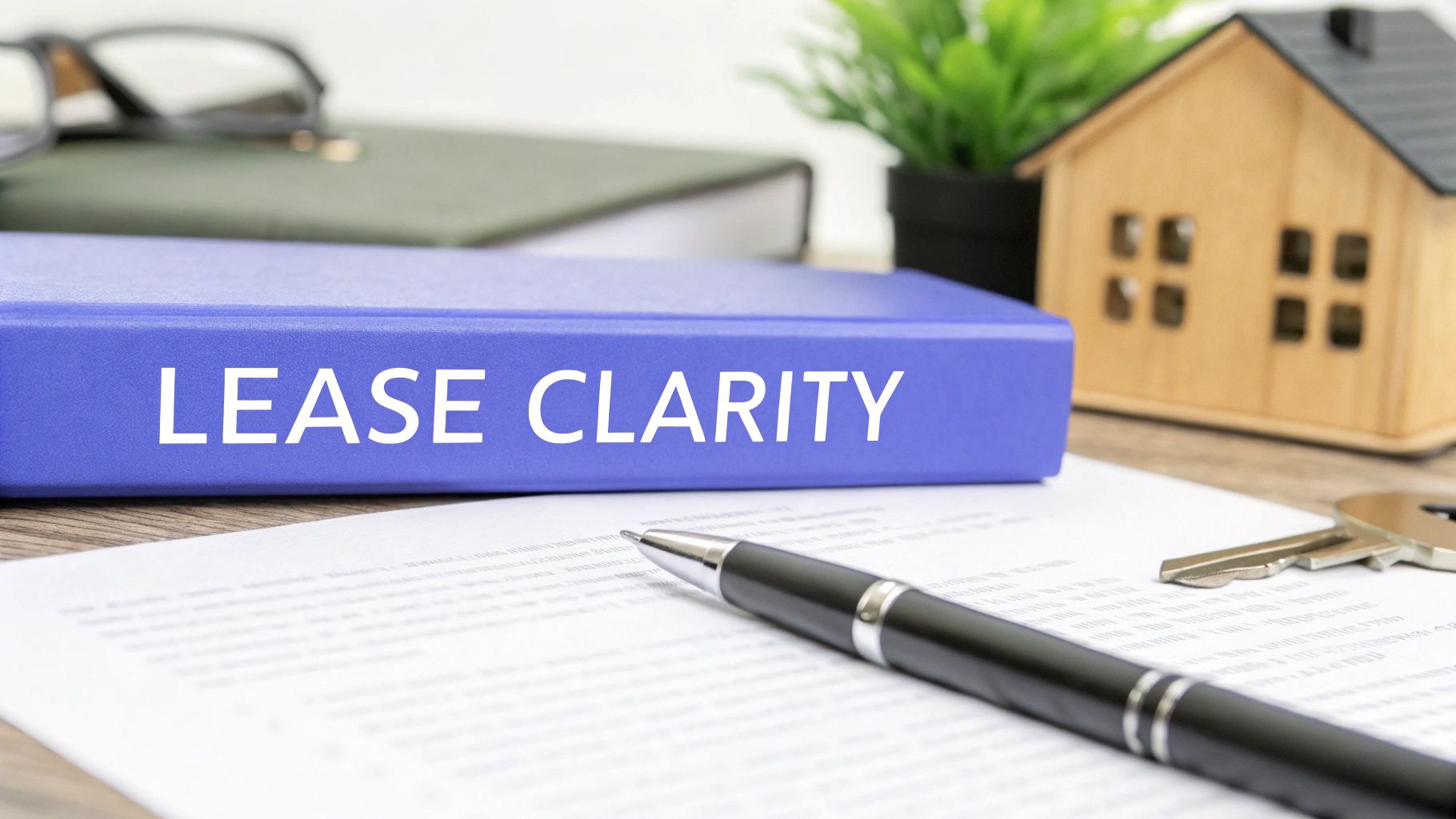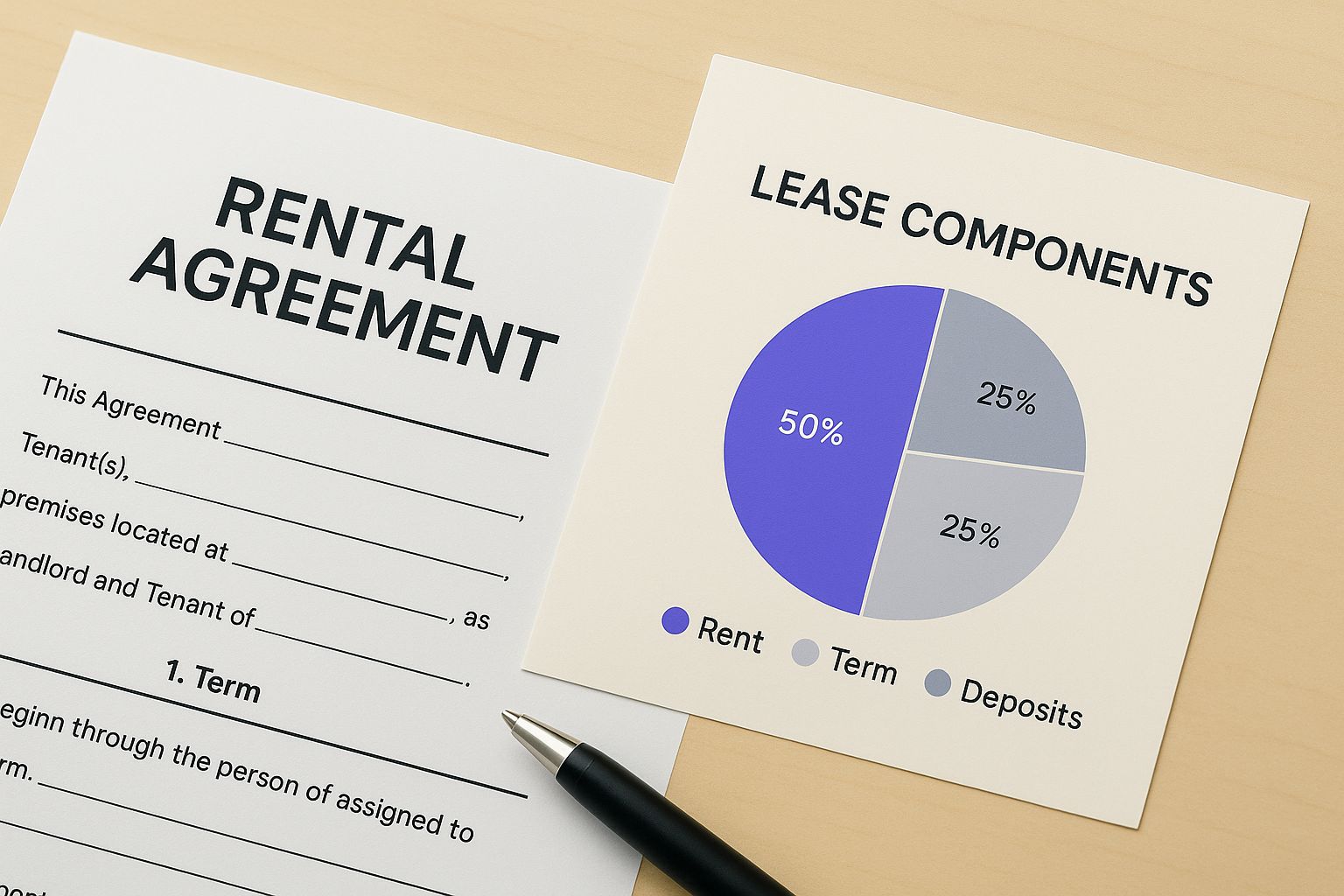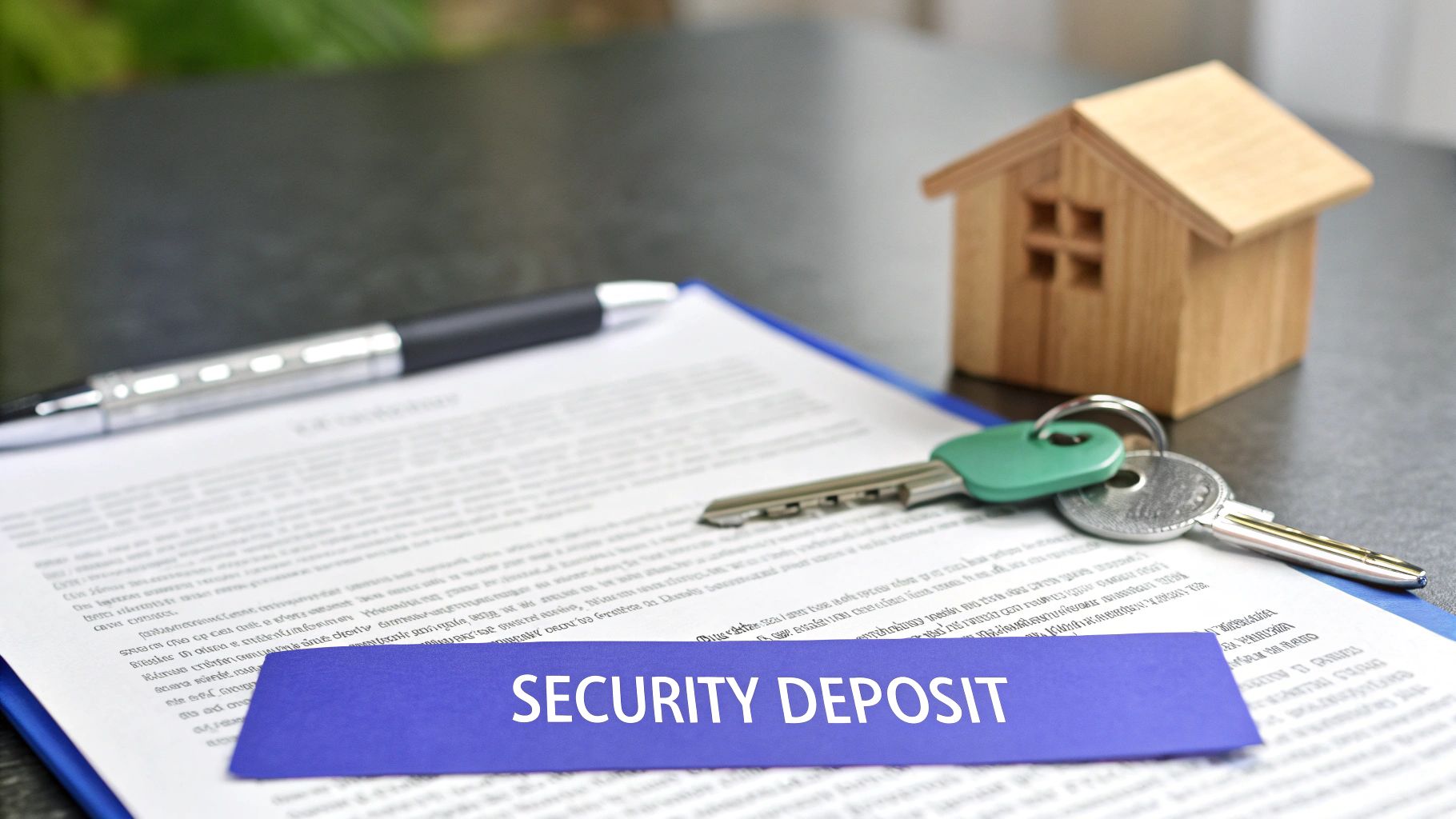
Decoding the Lease Agreement: Beyond the Fine Print
Understanding lease terms is crucial for both landlords and tenants. A lease agreement isn't just a formality; it's a legally binding contract outlining the terms of your tenancy. This means grasping every clause is vital to protect your rights and avoid future disagreements. For example, a misunderstood clause about maintenance could make you liable for expensive repairs that are the landlord's responsibility. This section helps you navigate a lease agreement's complexities and make informed decisions.
Key Components of a Lease Agreement
Every legitimate lease agreement includes key elements. These essential parts are the agreement's foundation and provide clarity for all involved. For example, the lease term specifies the rental duration, while the rent amount and payment schedule outline the financial obligations. The lease must also clearly state the property address and everyone's names. Overlooking these fundamentals can create ambiguity and potential conflict.
- Names of all parties: Clearly identifies the landlord and tenant(s)
- Property address: Specifies the rental property's exact location
- Lease term: Defines the rental agreement's length (e.g., one year, month-to-month)
- Rent amount and payment schedule: Specifies the rent amount and due date
- Security deposit details: Outlines the amount, return conditions, and allowed deductions
- Maintenance responsibilities: Clarifies who is responsible for repairs and upkeep
This detail ensures everyone is on the same page from the start. You might be interested in: How to master legal contracts.
Recognizing Red Flags in Lease Agreements
While essential components provide a framework, certain clauses can be warning signs. These potentially problematic parts may seem minor initially, but they can have significant consequences. Understanding these red flags helps you negotiate better terms or avoid detrimental agreements. One example is an automatic renewal clause locking you into another lease term without your direct agreement. Another common red flag is a broadly worded exculpatory clause shielding the landlord from liability for things they should legally be responsible for.
The global leasing industry has grown 76% in the last decade, highlighting the importance of understanding lease terms. In 2023 alone, new business volume rose 5.7%, showing leasing's continued importance in the global economy. Learn more about global leasing statistics. Effective negotiation leads to mutually agreeable lease terms and can be improved by using strategies to improve satisfaction and retention. This emphasizes the need to examine every lease agreement carefully before signing.
Money Matters: Mastering the Financial Terms That Count

This infographic illustrates the different parts of a lease, highlighting the "Lease Components" section. It stresses how important it is to grasp every piece of a lease agreement. Understanding these components gives you a clear picture of your financial duties and responsibilities as a tenant.
Knowing your lease, particularly the financial aspects, is crucial for protecting your wallet. This means carefully examining each financial clause, from how much rent you pay to the security deposit. Sometimes, leases contain hidden fees or confusing utility arrangements. This section will help you spot these traps and manage your money wisely throughout your tenancy.
Rent and Due Dates
Your lease should clearly state the rent amount and when it's due. It should also specify acceptable payment methods and any grace periods. This prevents late fees and helps maintain a good relationship with your landlord. Also, look for details about rent increases, including how often and by what percentage they can occur. This information helps you budget effectively and avoid unexpected costs.
Security Deposits: Protecting Your Money
The security deposit protects the landlord from damage or unpaid rent. Your lease should state the deposit amount, the terms for getting it back, and what deductions are allowed. Normal wear and tear shouldn't result in deductions. Documenting the property's condition before moving in, using photos and videos, is a good way to protect your deposit. This documentation proves the pre-existing condition of the property and helps avoid disagreements later.
Late Fees and Other Charges
Understanding how late fees work is crucial to avoid extra costs. Some leases have unfair late fee clauses that can add up quickly. Reviewing the fine print and understanding the legal terms is key. You can learn about common legal terms in a Letter of Intent (LOI). Also, carefully examine any clauses about utilities, making sure it's clear who pays for what. This prevents arguments and ensures you only pay for the utilities you're responsible for.
Negotiating for Better Financial Terms
Many people believe lease terms are fixed, but that isn’t always true. Knowing which financial terms are usually negotiable can save you money. You could negotiate a lower rent, a longer grace period for rent payments, or a clearer explanation of what can be deducted from your security deposit. The lease management market is expected to grow from $4.38 billion in 2024 to $4.63 billion in 2025. This growth underscores the importance of understanding and managing lease agreements effectively. You can find more statistics here. By understanding these financial terms and how to negotiate, you can confidently secure a lease that protects your financial well-being.
The following table provides a helpful overview of common financial terms found in lease agreements. It explains what each term means, what to look out for, and offers some tips for negotiating.
Common Financial Terms in Lease Agreements
| Term | Definition | What to Watch For | Negotiation Tips |
|---|---|---|---|
| Rent Amount | The monthly cost of renting the property. | Ensure it's within your budget and comparable to similar properties in the area. | Research local rental rates and try to negotiate a lower amount, especially if the property has drawbacks. |
| Due Date | The day rent is due each month. | Be aware of the grace period, if any, and penalties for late payment. | Request a longer grace period or a lower late fee. |
| Rent Increases | How and when the landlord can increase rent. | Note the frequency and percentage of allowed increases. | Negotiate limits on the amount and frequency of increases. |
| Security Deposit | Money held by the landlord to cover damages or unpaid rent. | Understand the conditions for its return and permissible deductions. | Negotiate a lower deposit or clearer guidelines for deductions. |
| Late Fees | Charges for paying rent after the due date. | Be wary of excessive or escalating fees. | Request a lower late fee or a longer grace period before fees apply. |
| Utilities | Responsibility for paying for services like water, electricity, and gas. | Clearly define who pays for which services. | Negotiate which utilities are included in the rent. |
By understanding these key terms, you can navigate your lease agreement with confidence and protect your financial interests. Remember, knowledge is power when it comes to negotiating a lease that works for you.
Time Commitments: Navigating Duration and Exit Strategies

A lease's timeframe is crucial for understanding its terms and how they affect your flexibility and long-term plans. This section explores the implications of lease duration, how to handle potentially problematic renewal clauses, and key exit strategies for various situations. This information will prepare you to manage your tenancy timeline effectively.
Lease Durations: Short-Term vs. Long-Term
Lease agreements come in various durations, each with its own set of advantages and disadvantages. Short-term leases, typically under a year, offer flexibility. However, they can come with higher rent and fewer opportunities for negotiation. Long-term leases (a year or more) provide stability and predictability, often with lower monthly rent. They also offer a greater chance to negotiate favorable terms. The best duration depends on your individual needs and future plans. A longer lease offers stability, while a shorter lease makes relocating easier.
Automatic Renewal Clauses: Friend or Foe?
Many leases have automatic renewal clauses. These clauses convert your lease to a month-to-month agreement or renew it for another fixed term after the initial period ends. While convenient, these clauses can also lock you into an undesirable situation. For instance, you might be stuck if the rent increases significantly upon renewal, or if building management declines. Always review these clauses carefully, noting any notification requirements to prevent unwanted extensions. Modifying or removing these clauses during initial negotiations can save you trouble later.
Exit Strategies: Breaking a Lease
Sometimes, life throws a curveball, and you need to break a lease. Understanding the legal requirements and potential financial implications is vital. Most leases specify penalties for breaking the agreement early. However, there are often valid reasons for breaking a lease without penalty, like military deployment or the landlord violating the lease terms. Be sure you understand the legal grounds for breaking a lease without significant costs. Always document all communication with your landlord. This documentation can be crucial if a dispute arises.
Subletting: An Alternative Exit
Subletting, or allowing someone else to temporarily take over your lease, can be a viable exit strategy if you need to move temporarily. However, your lease agreement must specifically allow subletting. Even with permission, you're still responsible for the rent and any damages caused by the subtenant. Understanding your rights and responsibilities regarding subletting offers a valuable safety net should your circumstances change. Interestingly, even the auto leasing market fluctuates, with projections showing a 41% decrease in lease returns in the first half of 2025 compared to the same period in 2024. More detailed statistics can be found here. This highlights the importance of anticipating potential changes and understanding the terms of any agreement, whether for property or vehicles. By understanding the time commitments within your lease agreement and your various options, you can navigate your tenancy with confidence and control.
Property Maintenance: Who's Really Responsible for What
Your lease agreement's maintenance section has a direct impact on your living experience and finances. It outlines the responsibilities of both landlord and tenant, offering a glimpse into what aspects are negotiable and what your rights are. Understanding these details can help ensure a comfortable living situation and prevent unexpected costs.
Defining Landlord and Tenant Responsibilities
Lease agreements should clearly state who is responsible for which maintenance tasks. Typically, landlords are responsible for structural repairs, such as fixing a leaky roof or a malfunctioning furnace. Tenants are generally responsible for minor upkeep, like replacing light bulbs and maintaining cleanliness.
However, the division of responsibility can become unclear. Consider a burst pipe due to a manufacturing defect. This appears to be the landlord's responsibility, but the tenant suffers the immediate consequence of a flooded bathroom. This ambiguity underscores the importance of well-defined responsibilities within the lease.
Documenting Pre-Existing Conditions
Before moving in, document any pre-existing damage. This documentation, including photos and videos, protects your security deposit by establishing the property's condition before your tenancy began. This simple step can prevent future disputes about liability for the damage. It safeguards tenants from unfair deductions from their security deposit. Learn more about best practices in our article about How to master contract management best practices.
Identifying Unfair Maintenance Clauses
Be wary of lease clauses that unfairly shift landlord responsibilities to tenants. For example, some leases might require tenants to cover repair costs resulting from normal wear and tear, a cost typically borne by the landlord. Negotiate for more equitable terms. Understanding lease terms involves careful review to protect your finances. This attention to detail can prevent future conflicts.
Emergency Repair Rights
Your lease notwithstanding, you have rights concerning emergency repairs. These include situations impacting your health and safety, like a lack of heat during winter or a malfunctioning sewage system. Landlords are legally obligated to address these issues promptly. Document all communication regarding these repairs to create a record of your requests and the landlord's actions. This documentation will be invaluable if further action is necessary.
Handling Repair Requests and Communication
Effective handling of repair requests ensures timely action and minimizes disagreements. Submit all requests in writing, detailing the problem and when it began. Keep copies of all communications with your landlord. This record-keeping helps clarify lease terms and protect your rights. It also helps avoid misunderstandings, even when communicating directly with your landlord.
By taking these steps, tenants gain a better understanding of their lease terms, protecting themselves from unjust charges and creating a more comfortable living space. Remember, understanding your lease agreement's specifics on property maintenance is crucial for a pleasant and hassle-free tenancy.
Hidden Landmines: Addendums and Special Clauses

Beyond the standard lease agreement, you'll often find addendums and special clauses. These additions can contain restrictive terms that impact your rights as a tenant. This section explores common lease supplements that are frequently overlooked, potentially leading to unexpected obligations.
Decoding Pet Agreements
Pet agreements are standard lease addendums. They outline the rules and restrictions regarding pets in the rental property. These typically detail acceptable pet types, size or breed restrictions, and any additional fees or deposits.
However, some pet agreement provisions might not be legally enforceable. For instance, blanket bans on certain breeds may face legal challenges in certain jurisdictions. Understanding the specific terms of your lease, especially pet addendums, is crucial for pet owners.
Roommate Clauses and Liability
Roommate clauses define the responsibilities and liabilities of tenants sharing a rental unit. These clauses can create unexpected issues. For example, a clause might make each tenant jointly and severally liable for the entire rent.
This means that if one roommate leaves without paying, the remaining tenants are responsible for the full amount. The lease might also restrict the number of occupants, limiting your ability to add roommates later. For additional information on contract clauses, check out our guide on important contract clauses.
Renovation Restrictions: Protecting Your Rights
Many leases include clauses restricting renovations or alterations to the property. Reasonable restrictions protect the landlord’s investment. However, some clauses infringe on tenant rights.
Prohibiting reasonable modifications for accessibility needs, for example, could be unlawful. Knowing these boundaries empowers you to negotiate reasonable modifications and protect your rights.
Exculpatory Clauses: Unfair Protection for Landlords
Exculpatory clauses attempt to release landlords from liability for issues they should legally be responsible for. This can include injuries resulting from negligence on the property.
However, the enforceability of these clauses is often limited, especially concerning essential services and safety concerns. Recognizing and challenging these clauses ensures landlord accountability.
Modern Lease Clauses: Technology and Home Businesses
Modern leases are incorporating clauses addressing technology and home-based businesses. These might cover smart home device installations, internet usage, and conducting business activities within the rental.
Understanding these clauses is especially important for tenants working remotely or who rely heavily on technology. These provisions can significantly affect your lifestyle and professional activities.
Negotiating Addendums and Special Clauses
Remember, many addendums and special clauses are negotiable. Like the core lease terms, you can often discuss and modify these provisions. This can lead to a more balanced agreement.
Negotiation can involve removing problematic clauses, clarifying ambiguous language, or adding provisions to protect your interests. Understanding your rights and being prepared to negotiate helps you avoid pitfalls and create a lease that meets your needs. Being proactive ensures a fair rental agreement.
Knowing Your Rights: The Tenant Protections You Can't Sign Away
Understanding your lease is important, but it's equally vital to know that some tenant rights are non-negotiable, no matter what your lease says. These protections exist at the federal and state levels, empowering you to advocate for yourself.
Essential Habitability Standards
Landlords are legally required to maintain habitable living conditions. This includes functioning plumbing, heating, and electrical systems, as well as handling pest control and structural repairs. These implied warranty of habitability standards apply even if your lease doesn't specifically mention them. For example, a landlord can't legally ignore a broken heating system in winter, even if the lease doesn't mention heating. Knowing these standards ensures a safe and healthy home.
Privacy Rights: Balancing Landlord Access
Landlords have a right to access their property for legitimate reasons like maintenance or inspections. However, tenants also have privacy rights. Landlords must generally provide reasonable notice before entering your unit, except in emergencies. This balances landlord access with tenant privacy. Your lease may specify the notice period, but it cannot eliminate your right to privacy in your home.
Eviction Procedures: Legal Steps Landlords Must Follow
Landlords must adhere to specific legal procedures for evictions, regardless of what your lease states. This includes providing proper notice, filing the necessary paperwork with the court, and giving tenants a chance to respond to the eviction notice. A landlord can't simply change the locks or remove your belongings without following due process. Understanding these procedures protects you from unlawful eviction.
Documentation: Your Strongest Ally in Disputes
Keep records of your lease, rent receipts, maintenance requests, and all communication with your landlord. Photos and videos of pre-existing damage and subsequent repairs are also valuable. This documentation supports your claims and shows you've acted responsibly. Comprehensive records are crucial for asserting your rights.
Resources for Legal Assistance: Affordable and Accessible Help
Several resources provide affordable or free legal help if your landlord violates your rights. Tenant unions, legal aid organizations, and local bar associations offer guidance and representation. Many state and local governments also have tenant rights agencies. Don't hesitate to seek help if you experience unlawful treatment; these resources provide essential support in navigating landlord-tenant law.
To understand your rights better, review the table below summarizing key tenant protections during different phases of a lease.
Understanding your rights at each stage of the leasing process is crucial. The following table provides a clear outline to help you navigate your tenancy.
Tenant Rights by Lease Phase
| Lease Phase | Key Tenant Rights | Relevant Laws (Examples) | Action Steps if Rights Violated |
|---|---|---|---|
| Before Signing | Right to a habitable dwelling, right to see the lease before signing, right to ask questions | Fair Housing Act, State Landlord-Tenant Laws | Contact local housing authority, consult with an attorney |
| During Tenancy | Right to quiet enjoyment, right to privacy, right to have repairs made | Implied Warranty of Habitability, State Landlord-Tenant Laws | Contact landlord in writing, contact local housing authority |
| Ending Lease | Right to proper notice of termination, right to return of security deposit (if applicable) | State Landlord-Tenant Laws | Contact landlord in writing, consult with an attorney |
This table provides a general overview. Specific rights and laws can vary by location. Always consult with local housing authorities or legal professionals for advice tailored to your situation. Knowing your rights empowers you to ensure fair treatment and a safe, secure tenancy.
Winning the Negotiation Game: Tactics That Actually Work
Contrary to popular belief, lease terms aren't always fixed. With the right strategy, you can often negotiate better conditions. This section reveals practical tactics savvy renters use to secure more favorable terms, from smart timing to pinpointing flexible clauses. This empowers you to create a lease agreement that truly works for you.
Timing Is Everything: When to Negotiate
Your negotiating power is often strongest before signing the lease. Landlords are more eager to secure a tenant then, especially in a competitive market. For example, if many apartments are available, landlords might be more willing to compromise. However, even during your tenancy, you can renegotiate certain terms, particularly upon renewal. Understanding market dynamics maximizes your influence.
Identifying Negotiable Clauses: Knowing Your Priorities
Not all lease clauses are the same. Some, like the rent amount and lease duration, are frequently up for discussion. Others, like legally required disclosures, are less flexible. Prioritize the terms most important to you. For instance, if having a pet is crucial, concentrate your efforts there. Knowing your priorities allows for focused negotiation.
What to Say: Making Your Case Effectively
When requesting changes, be clear, respectful, and ready to explain your reasoning. For example, instead of simply asking for lower rent, explain why you think it’s justified. Perhaps similar units nearby are less expensive, or the property has some downsides. Backing up your requests with evidence strengthens your argument.
Documenting Verbal Agreements: Protecting Your Interests
While a lease is a written agreement, verbal agreements can also be legally binding. However, proving verbal agreements can be difficult. Always follow up spoken agreements with written confirmation, either by email or a formal letter. This protects you should disagreements arise later.
Real-World Examples: Learning from Successful Negotiations
Consider a tenant who successfully negotiated lower rent by pointing out necessary repairs the landlord hadn't addressed. Another tenant secured pet permission by offering a larger security deposit. These examples show that effective negotiation often means finding solutions that benefit both sides.
Market Conditions: Leveraging Your Position
Understanding current market conditions helps your negotiating position. If there are many available rentals, landlords may be more open to concessions to avoid vacancies. Conversely, in a tight market, landlords have less reason to negotiate. Knowing this lets you adjust your strategy.
Professional Communication: Building Rapport and Respect
Maintain a professional and respectful tone throughout negotiations. This approach builds a good relationship with the landlord or property manager. Present your requests logically and calmly. Avoid aggressive language or unrealistic demands. This respectful approach encourages a cooperative environment.
Enforceable Agreements: Ensuring Your Negotiated Terms Stick
After successfully negotiating changes, make sure they are included in the final lease agreement. Don't rely on verbal promises. The updated lease is your legal protection. This safeguards your interests and prevents future disputes.
By using these tactics, you'll become a more confident negotiator, able to create a lease agreement that truly meets your needs. You’ll shift from passively accepting standard terms to actively shaping an agreement that balances your requirements with the landlord's.
Ready to simplify your lease agreements and better understand your legal documents? Visit Legal Document Simplifier today and explore the power of AI-driven legal analysis. Our platform helps you decipher complex legal language, identify essential terms, and manage your legal obligations confidently. Don't navigate the world of legal documents alone; let Legal Document Simplifier guide you.